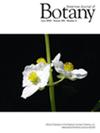Tank formation transforms nitrogen metabolism of an epiphytic bromeliad and its phyllosphere bacteria
Abstract
Premise
Up to half of tropical forest plant species grow on other plants. Lacking access to soils, vascular epiphytes have unique adaptations for mineral nutrition. Among the most distinctive is the tank growth form of certain large bromeliads, which absorb nutrients that are cycled by complex microbial communities in water trapped among their overlapping leaf bases. However, tanks form only after years of growth by juvenile plants, which must acquire nutrients differently. Understanding how nutrient dynamics change during tank bromeliad development can provide key insights into the role of microorganisms in the maintenance of tropical forest biodiversity.
Methods
We evaluated variations in plant morphology, growth, foliar nitrogen physiology, and phyllosphere bacterial communities along a size gradient spanning the transition to tank formation in the threatened species Tillandsia utriculata.
Results
Sequential morphological and growth phases coincided with the transition to tank formation when the longest leaf on plants was between 14 and 19 cm. Before this point, foliar ammonium concentrations were very high, but after, leaf segments absorbed significantly more nitrate. Leaf-surface bacterial communities tracked ontogenetic changes in plant morphology and nitrogen metabolism, with less-diverse communities in tankless plants distinguished by a high proportion of taxa implicated in ureolysis, nitrogen fixation, and methanotrophy, whereas nitrate reduction characterized communities on individuals that could form a tank.
Conclusions
Coupled changes in plant morphology, physiology, and microbiome function facilitate the transition between alternative nutritional modes in tank bromeliads. Comparing bromeliads across life stages and habitats may illuminate how nitrogen-use varies across scales.

 求助内容:
求助内容: 应助结果提醒方式:
应助结果提醒方式:


